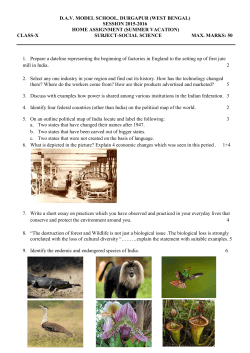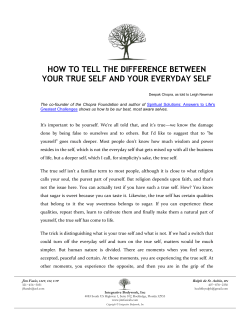
Subject Area: Visual Arts Grades: Middle School, High School Topic/Theme: Observing Art in Everyday Things Lesson Plan: Everyday Beauty
Lesson Plan: Everyday Beauty Subject Area: Visual Arts Grades: Middle School, High School Topic/Theme: Observing Art in Everyday Things Everyday Beauty: The theme of “Everyday Beauty” refers to the creation of high quality objects that are beautiful, well‐made, and useful. This is an important characteristic of Islamic art and can be found throughout the exhibition. Most pieces of Islamic art are useful in addition to being beautiful, whether it is a water filter or a piece of architecture. This ornamentation includes the use of calligraphy, geometric patterns, vegetal (also called arabesque) patterns, and figures. Water filter with lion design, 10th‐12th centuries, Fustat (medieval Cairo), Egypt, hand‐tooled and pierced clay. Kelsey Museum of Archaeology, 1971.01.0003. 1 Goals: ‐ ‐ ‐ To recognize ways art can be incorporated into everyday items To draw comparisons between medieval Islamic artifacts and modern everyday items with which students are familiar To use visual evidence to support inferences Questions for Viewing Object: ‐ ‐ ‐ ‐ ‐ ‐ Look at the image for a minute or two. Describe what you see. How was the object used? Is the decoration functional? How does it function? Do you think the original owner thought of this as a piece of art as well as a useful tool? Do you have something at home that performs the same function? Would you consider your object to be art? Classroom Activity: Supplies: Paper, compass, pencils, scissors, air drying clay or sculpey, rolling pins, clay‐working tools. Using clay, students will make their own water sieves. First, have each student on a piece of paper create a circle 4‐5 inches in diameter using a compass. Next, have them sketch out a design or image within the circle, like the rabbit on the Kelsey Museum piece. Have each student cut out their image or design to use as a template. Give each student a portion of clay and tools. Using the rolling pin, have them create round disks of clay roughly 4‐5 inches in diameter. Place their paper templates within the clay circle and have them pierce holes with the clay‐working tools in the clay not covered by the paper. Allow the disks to dry. Once the disks have dried, the students can test how effective their water sieve designs are using water or sand. Have the students discuss how certain patterns are more effective than others, and what they see and think about everyday items as art. Alternative activity: Ask students to select an object they use every day in the classroom, such as chalk boards, pencil cases, desks, etc. Using the questions above, have the students interrogate and discuss their everyday objects as they did with the museum piece. Instead of “Do you have something at home that performs the same function?” students could also be asked “Imagine you’re an archaeologist 1000 years from now and you’ve never seen an object like this before. How do you think was this object was used? Would you consider this object to be art?” 2 Common Core Standards: ART.VA.IV.6 – HS Standard 4: Understand, analyze, and describe the arts in their historical, social, and cultural contexts National Learning Standards: Visual Arts NA‐VA.K‐12.4 Understanding the Visual Arts in Relation to History and Cultures 3
© Copyright 2025





















